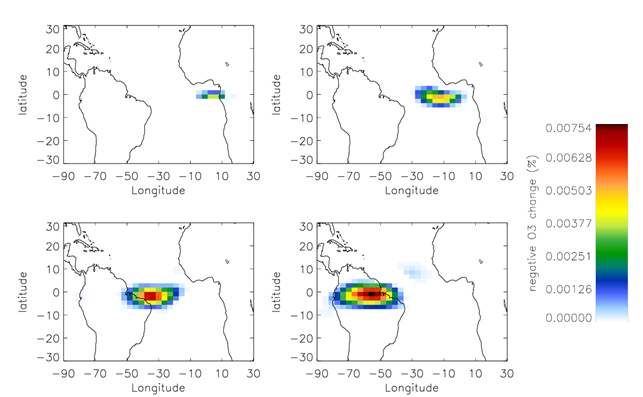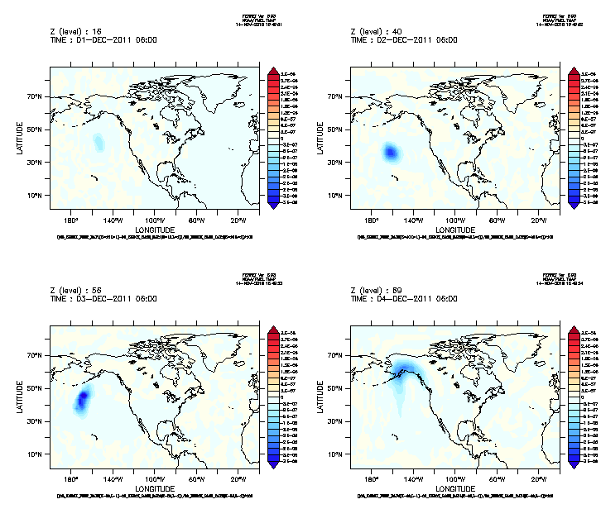ESA wants to know the atmospheric impact of spacecraft demise upon reentry. For this reason, the Agency has initiated two studies carried out by Varuna and Thalès Alenia Space Italy (TAS-I) in 2019. This post brings you with the main results of these studies and tries to draw some first conclusions from them.
In the lifecycle of a spacecraft orbiting in Low Earth Orbit (LEO), the reentry phase is a key moment in the end-of-life of the satellite. During this phase, the spacecraft is subject to extreme mechanical and thermal stresses and experiences mass demise from break-up, ablation and physical-chemical reactions. Gas and particle end-products are released into the atmosphere. The nature of those substances is expected to be varied: some are toxic, others (metal oxide particles, chlorine, nitrogen oxides) can induce ozone depletion and some also interact with the environment modifying the radiative balance and thus climate.
Consequently, the ATmospheric Impact of SPAcecraft DEmise (ATISPADE) and Atmospheric Reentry Assessment (ARA) studies were carried out respectively by Varuna and TAS-I to try to assess the atmospheric impacts of spacecraft demise on both short and long-term scales. A key objective was to evaluate potential ozone depletion due to reentry events, the radiative forcing variations and the resulting on-ground level of toxicity. The approach also intended to identify the main uncertainties in the proposed results.
The methodology employed in the two studies was rather similar: a representative satellite and upper stage body were selected among various candidates based on typical material compositions and their impacts were assessed by applying a range of numerical models for different reentry configurations. The aerothermodynamics model simulations provided mass loss maps, which, along with chemical ablation and Computational Fluid Dynamics (CFD) calculations for each material, gave the relevant gases and particles released. Subsequently, the gaseous and particulate reentry emissions were used as inputs in atmospheric models to evaluate the different impacts on the atmosphere. Particular attention was given to emissions of ozone-destroying substances, notably chlorine contained in spacecraft materials and nitrogen oxides generated during reentry in the hot exhausts. The two parallel studies followed the same approach but made their own assumptions using different models (for aerothermodynamics and atmospheric chemistry-dynamics).
For the ARA study, a LEO spacecraft and upper stage rocket body were chosen to estimate their current and future reentries. The survey was mostly based on the database of Systems Tool Kit (STK) – a multi-physics software application that enables engineers and scientists to perform complex analyses of space platforms. The representative spacecraft used was derived from the study case of Sentinel 1 and the tool TADAP developed by TAS-I simulated the ablated mass for both controlled and uncontrolled reentries (with different sensibilities in forced convective flux and atmospheric density). The output in terms of ablated mass per material, was used via dedicated methodologies to evaluate the by-products, taking into account the thermodynamics of the materials and specific conditions, such as ablated mass release altitude and velocity (trajectory path). Then two global reentry scenarios, in terms of emitted / by-products mass, were defined: nominal and worst-case. The worst-case scenario took into account the forecasted launch of various mega-constellations between 2017 and 2030, including Planet Labs, SpaceX and OneWeb. The two scenarios resulted respectively in 73 reentry events per year and 314 events per year. Regarding the coupled chemistry-climate simulation, which adopts the mentioned global reentry scenarios as input, the ECHAM/MESSy (EMAC) was used, and further season sensibility was added.
In the ATISPADE study, the reentries over a 200-year period were predicted through DAMAGE (Debris Analysis and Monitoring Architecture to the GEO Environment) in the cases of a nominal and worst-case scenario (that included a future 1080 satellite constellation). The prediction was compared to the ESA DISCOS historical dataset. The 2053-2063 period in the DAMAGE reentry projection, representative of the historically high reentry period of the 70s-80s, was chosen as the standard reentry frequency scenario for the atmospheric simulations. To be conservative, two key assumptions were made: a 90% compliance with the space debris mitigation guidelines and the complete demise of the considered space object (total mass is ablated). A subsequent step was then to assess emissions from eight single entries with a combination of different factors (spacecraft/upper body, controlled/uncontrolled, best/worst-case scenario). Finally, the four worst-case scenarios were used as gaseous emission inputs into a 3D atmospheric chemistry-transport model.
The main results show that the atmospheric short-term impact due to a single spacecraft demise is modest. The dispersion of the plume created by a large single reentry event induces an atmospheric ozone destruction on a regional scale with maximum peak ozone loss of less than 1% on the first day, becoming totally negligible after a week (thus much smaller than its natural variability).
Long-term simulations were six years long for the ARA study and ten years long for the ATISPADE study. In both cases, it was shown that the greatest impact is observed in the mesosphere and the upper stratosphere and is only significant in polar regions. Indeed, even in the worst-case scenario, the average annual global mean ozone loss is found to be between 0.17×10–4 % and 8×10–4 %, while the Antarctic local ozone concentration change can reach about 0.05%. Those impacts are negligible when compared to the impact of anthropogenic activities, in particular emissions of industrial halogen-containing substances such as CFCs, that caused a global ozone loss of 3-4% (since 1970).
Regarding the climate impact, the stratospheric-adjusted radiative forcing due to the demise of space objects was calculated in the ARA study. The potential climate impact of the nominal scenario was substantially smaller than those of rocket launches, aviation, and road sector. In the worst-case scenario, the potential climate impact was 222 times less than one rocket launch, 2.9×10^5 times less than annual aviation contribution and 6.5×10^5 times less impacting than the annual road transportation sector. The climate forcing was mainly due to the effects of ozone depletion and water vapor change. The study did not include the direct radiative impact of solid particles (soot, Al2O3 and TiO2), only their indirect impact via their ozone-destroying effect. Regarding toxicity, both studies agree that the impact of toxic materials reaching the surface even in the long term is negligible.
It is also important to accurately consider the assumptions that were made and that led to these conclusions.


Overall, the ARA, ATISPADE and DISCOS reentry mass rates, the most important parameter for ozone loss, for the worse case scenarios (highly enhanced reentry periods) are relatively consistent with values ranging between 450 tonnes per year (ATISPADE) to 764 tonnes per year (ARA) and a value of 550 tonnes per year in the DISCOS historical data. ATISPADE assumed 90% compliance with the space debris mitigation requirement, while current rates are known to be much lower, and this corresponds to fewer reentries. Among significant differences between the two studies, one concerns how much nitrogen oxides and chlorine are released during reentry events depending on assumptions regarding aerothermodynamics and material modelling. It is known that emissions can vary greatly depending on the assumed reentry trajectory, with emissions being lower for steeper reentries. Furthermore, despite great developments in the field of demise and reentry models in the past years, uncertainties remain large. The same holds for atmospheric chemistry-transport models that were used within these studies.
To conclude, while both studies agree that the atmospheric impact of spacecraft reentries is relatively low, there are still high-level uncertainties on aerothermodynamics and atmospheric chemistry-transport modelling and a lack of observational (in-situ) data to evaluate assumptions and models. Further detailed assessments on first reentry plumes should also be made, with a greater emphasis on local and regional scales, especially in the polar region, to better quantify atmospheric impacts.
This post has been prepared with the support of Benedetta Cattani and Enrico Tormena.





Discussion: one comment
the FFC evaluation is partially based on the results of these studies from ESA
https://www.fcc.gov/document/fcc-partially-grants-spacex-gen2-broadband-satellite-application
The permit is granted for a first batch of 7500 units, at least twice as heavy as te previous constellation, and the request was for 30.000 units. Would it be possible to read the studies ?
Thank you in advance